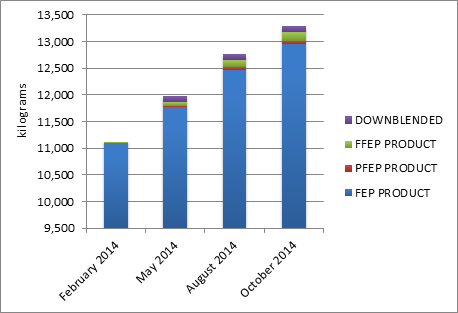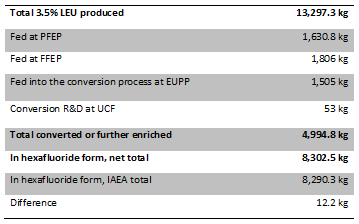Reports
Evaluating Iran’s Stock of Less than Five Percent Low Enriched Uranium
by David Albright and Paulina Izewicz
November 18, 2014
Iran’s stock of 3.5 percent low enriched uranium (LEU) hexafluoride has increased during the last few months. To meet its obligations under the interim deal of the Joint Plan of Action, Iran needs to convert about 500 kilograms of 3.5 percent LEU hexafluoride to oxide form prior to November 24, 2014.
The November 7, 2014 Iran Safeguards Report by the International Atomic Energy Agency (IAEA) provides an accounting of Iran’s cumulative production and utilization of low enriched uranium enriched up to 5 percent in the isotope uranium 235. The vast bulk of this LEU is estimated to have an average enrichment of about 3.5 percent LEU, which is how this material is referred to here.
Under the Joint Plan of Action (JPA), Iran continues the production of 3.5 percent low enriched uranium, having produced an additional 525.3 kilograms of 3.5 percent LEU hexafluoride in this most recent reporting period at a rate consistent with past activity. Compared with the last reporting period when Iran’s stock of 3.5 percent LEU hexafluoride had decreased due to the feeding of this material into a conversion process to make uranium oxide, the total stock in the hexafluoride form increased since the previous report by the IAEA.
Total Production and Drawdowns
In total, since the beginning of enrichment activities, Iran has produced 13,297.3 kilograms of about 3.5 percent uranium hexafluoride (UF6). Between February 2007 and October 14, 2014, 12,945 kilograms of this material was produced at the Fuel Enrichment Plant (FEP) at Natanz, 62.7 kilograms1 at the Pilot Fuel Enrichment Plant (PFEP) at the same location between January 20, 2014 and October 10 2014, and 174 kilograms was produced at the Fordow Fuel Enrichment Plant (FFEP) between January 20, 2014 and October 11, 2014. A total of 115.6 kilograms of less than five percent LEU had been produced from the downblending of the near 20 percent LEU, which Iran committed to processing under the Joint Plan of Action. Figure 1 shows the growth in the total amount of LEU produced from February 2014 to October 2014. As can be seen Iran has produced about 2,000 kilograms of 3.5 percent LEU hexafluoride during the period of the JPA.

Figure 1: Amounts of 3.5 percent LEU produced by source in hexafluoride mass since February 2014. Source: Implementation of the NPT Safeguards Agreement and relevant provisions of Security Council resolutions in the Islamic Republic of Iran, February - November 2014.
Overall, Iran fed 1,630.8 kilograms of about 3.5 percent LEU hexafluoride at PFEP and 1,806 kilograms at FFEP to produce near 20 percent LEU prior to January 20, 2014. As of November 2012, Iran had fed 53 kilograms into the research & development (R&D) process at the Uranium Conversion Facility at Esfahan, and produced 24 kilograms of uranium oxide; 13.6 kilograms of this material were used for the production of two test fuel rods (500 grams each) and two fuel rod assemblies (6 kilograms each).2
Considering the total production and subsequent use of this material, the total amount of 3.5 percent LEU hexafluoride is 8,302.5 kilograms, as of the end of this reporting period (see table 1). ISIS has arrived at a slightly different estimate from the IAEA’s value of 8,290.3 kilograms listed in the corrected report. The difference between the two numbers is 12.2 kilograms. This difference has been present since late last year, when the difference was 0.4 kilograms. Prior to that, the values matched. The reason for these small differences is unknown, although one possible explanation is that this material remains in process or in waste; it may also reflect the different reporting periods for each enrichment facility.

Freezing the Stock of LEU Hex
Since the implementation of the Joint Plan of Action in January 2014, as discussed above, Iran has produced about 2,000 kilograms of 3.5 percent LEU hexafluoride. This is enough material, if further enriched to weapon-grade, for one nuclear weapon, where the weapon is assumed to require 25 kilograms of weapon-grade uranium. Because of concern of adding to Iran’s nuclear weapons capability, under the JPA Iran has committed to convert all of this material to oxide form, namely any newly produced LEU during the interim period would be converted into oxide form. If the material is in oxide form it would require additional processing, namely reconversion to hexafluoride form, before it could be further enriched. Although the conversion to oxide form does not prevent its use to make nuclear weapons, such conversion complicates its misuse.
Under the JPA, Iran needs to convert at least another 500 kilograms of LEU hexafluoride to oxide form by the November 24th deadline. It has already fed about 1,500 kilograms of newly produced LEU hexafluoride into a conversion plant to make oxide. However, it is unknown how much LEU oxide this plant has made.
In May 2014 Iran began commissioning the Enriched UO2 Powder Plant pursuant to its obligation under the JPA to convert into oxide any 3.5 percent LEU produced during the interim period. The plant began operations in May 2014 using natural uranium hexafluoride. Iran fed a total of 4.174 kilograms of natural uranium hexafluoride into the conversion process and produced 553 kilograms of uranium oxide in the form of U3O8. In July 2014, Iran started feeding in LEU hexafluoride into the plant. It has fed 1,505 kilograms (1,016 kg uranium mass) of LEU enriched up to five percent into the conversion process for the production of UO2. However, the report provides no indication of how much LEU oxide has been produced, unlike in other conversion cases. For example, the IAEA gave figures for the amount of natural uranium oxide produced during the initial operation of this same plant, as mentioned above. Given the number of months since the LEU hexafluoride was fed into the conversion process, uranium oxide should have been produced by today. Some of the LEU of course will remain in the process lines and another fraction could be in scrap or waste. One question is whether any remains in hexafluoride form in storage tanks hooked to the conversion lines.
Downblending of Tails and Dump Tank LEU
On August 17, 2014, Iran informed the IAEA that it would downblend approximately 4,118 kilograms of uranium enriched up to 2 percent to natural uranium. This material comprises LEU in tails from the production of near 20 percent LEU and material evacuated from the cascades producing about 3.5 percent LEU. It is separate from the 3.5 percent LEU described above. In its October monthly report, the IAEA confirmed that Iran has complied with this obligation, and has diluted the entire amount to the level of natural uranium. Approximately 22 kilograms of this nuclear material remained in the dilution equipment. The November quarterly report provides the amount of natural uranium produced in the process, which totals 7,706 kilograms.
1 This number comprises the amount verified by the IAEA as of September 13, and an estimate by Iran covering the period of September 14 to October 10. 2 IAEA Director General, Implementation of the NPT Safeguards Agreement and relevant provisions of Security Council resolutions in the Islamic Republic of Iran, GOV/2012/55, November 16, 2012, https://www.iaea.org/Publications/Documents/Board/2012/gov2012-55.pdf.

 twitter
twitter